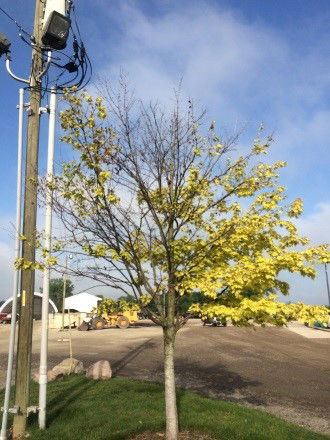Iron Chlorosis

What causes this?
Iron Chlorosis is the deficiency of iron in a plant. In most cases it is preventable and treatable. The most common trees to show symptoms of iron deficiency are red maples, pin oaks, and river birch trees in suburban areas.
What happens?
The iron that is in the ground is unavailable, and slowly the tree runs low of this micronutrient. Our soil pH is a little higher than what most plants prefer. Most plants do best when the soil pH is 6.5, but here in Missouri, we range from 5.5-6.
How do we treat it?
There are three common methods to treat this ailment. First, you can inject your tree with iron products, and that works the fastest. You will see a change in your tree within a week or two, but sadly it only lasts 6-8 weeks. I would recommend this method if there is an important event going to happen in the middle of the summer such as a wedding. The second method is deep root feeding your tree with fertilizers. The “deep root” means that we will insert a probe under the grass root line so it is directly implemented to the tree’s roots. Granular applications don’t work well because grass roots will absorb most of the nutrients before tree roots get them. This method is typically done in spring and fall because there is more rainfall to disperse the nutrients around. Usually the tree will benefit from these fertilizers for about 6 months. Finally, the last method is to address the problem and that is lowering the pH of the soil. This method typically lasts 2 years when done correctly. But since the rain will have a higher pH than the new adjusted soil, it will slowly fade away. Results can be seen in about a month, and will last for the longest period of time. Adding lime will raise the soil pH of your soil. Just make sure not to add too much.
It takes years for a tree to decline from iron deficiency, and it will take years for it to be a perfect green again. Plan on maintaining your tree on a program for a while to get the results you want.